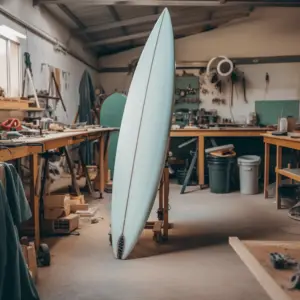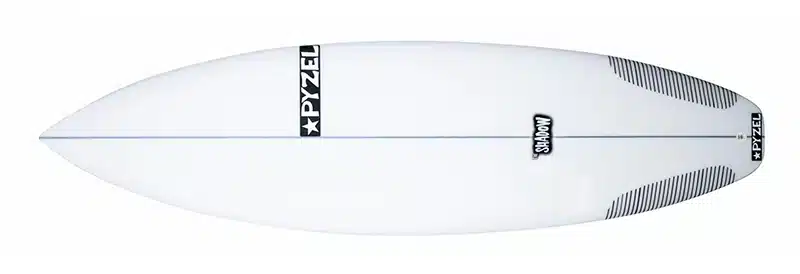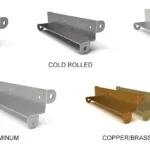If you’re starting and planning to buy a surfboard, it is crucial to know the differences and benefits of various boards to make an informative decision that matches your needs.
Polyurethane (PU), also known as fiberglass surfboards, are traditional boards that are popular. They are made from a polyurethane inner and then wrapped in fiberglass cloth. The surfboards flex better in the waves than Epoxy, thus prone to damage.
Table of Contents
Epoxy vs Fiberglass Surfboards

On the other hand, Epoxy is space-age tech for surfboards. They’re lighter, stronger, and hardier than the PU boards. They have a polystyrene foam core and are then coated with an epoxy resin. It is a new generation surfboard that rose to popularity in 2005 after the Clark Foam factory’s closure (a massive polyurethane supplier).
For a detailed breakdown of the two surfboards and the parameters that make you choose one over the other, read this article to the end.
Epoxy vs Fiberglass
A surfing board is one of the essential tools required to adventure the sport of surfing. Good quality surfing boards make you feel comfortable and secure as you ride the high waves in the open sea.
Fiberglass is rigid and provides more stability, hence a favorite of the experienced surfer. Epoxy surfing board is lightweight and easy to maneuver and carry around; therefore a choice for beginners.
Here is a snippet of the personalized benefits given by each.
| Features | Epoxy Surfboards | Fiberglass Surfboards |
| Material | Polystyrene | Polyurethane |
| Flexibility | Stiffer and complex to use | Flexible and easy to use |
| Affordability | Pricier | Less costly |
| Effect of water | It doesn’t get ruined by water | Get delaminated if it absorbs water |
| Ease of use | Easy to use and lightweight | Challenge to carry around, and they’re bulky and heavy |
| Durability | ||
| Sun Damage | Resistant to sun damage | Susceptible to damage by the UV rays of the sun |
Epoxy vs Fiberglass Surfboard Overview
Both surfboards are better. However, if you are a beginner surfer, the Epoxy is a better choice for you, while for the pioneer surfer who requires better features, fiberglass ones are a great choice.
The most crucial factor to consider is your comfortability because it has to fit your personal preference. Epoxy is 35% stronger than fiberglass materials. For effortless paddling, the epoxy surfboard leads as it helps you catch waves easily compared to its fiberglass counterpart.
Fiberglass boards are affordable due to material flexibility, which gives them the desired shape. They have extraordinary shocking abilities. Nevertheless, the lightweight epoxy surfboard is convenient to carry around.
Fiberglass doesn’t last long, resulting in waste to the environment, unlike epoxy resin boards, which are long-lasting; thus, using them adds to your carbon footprint. However, none of the two is biodegradable and should be disposed of carefully to prevent environmental damage.
Epoxy Surfboards
Also known as EPS. Open cell foam is formed from polystyrene foam cores expanded with steam and fused. Epoxy surfboards offer high buoyancy, have less density, and are softer but more robust than the resin or polyester resin coated on the surfboards. They’re eco-friendly too.
Epoxy Surfboards Pros and Cons
If you consider purchasing this type of surfboard, here is why
Benefits
Durability– They have the strength and are more durable than their counterparts, fiberglass, which makes them a favorite for beginners, people who prefer something less prone to dings
Weight- They are lighter than the PU counterparts hence perfect for those who travel a lot as they cut down on your baggage eight.
They are eco-friendly- they may not be biodegradable, but their ability to last long reduces wastage in the environment, unlike polyurethane.
Buoyancy- Epoxy surfboards tend to float better than their fiberglass counterparts. Thanks to the foam core that is less dense than PU. The boards are made from EPS foam blanks which are lighter weight offering better buoyancy.
Don’t get Waterlogged- Waterlogging is rare because of its hardness, unlike fiberglass, which absorbs water due to dings and dents or aging.
Suitable for newbies
Downsides
Pricing- Epoxy surfboards come at higher prices than other surfboards. Although considering the durability element, the extra bucks are worth it.
Hard to repair- should they get damaged, they’re hard to repair
Weight- Due to their lightweight, they don’t handle great winds, making them feel “chattery” underfoot, especially if you’re riding on a shortboard. Besides, the added buoyancy is not enticing to experienced surfers
Not highly preferable by some surfers, especially the experts
Fiberglass Surfboards
Surfboards are composed of polyurethane blanks, like yoga mats, skateboard wheels, and tires. It coats fiberglass. One of the traditional fiberglass surfboards.
Fiberglass Pros and Cons
It has better flex in waves than epoxy surfboard; thus, fiberglass surfboard is excellent for better performance.
Pros
Sturdy and stiff-
Catches waves better- They have additional control and comfortable flex, which can help you rip easier.
Smoother performance- Because they sit lower in the water, they are easy to navigate when you want to turn.
Affordable: Fiberglass surfboards are relatively cheap to produce, making them easily accessible for surfers
They are easy to repair if you happen to bump into an accident
Cons
Prone to waterlogging- when the fiberglass gets dents or cracks, it starts to absorb water. As a result, the surfboard becomes heavier and will not float. In addition, they begin to discolor, delaminate and continue for longer.
Buoyancy- Fiberglass boards are not as good as Epoxy when it comes to floating. As a beginner, you’ll find it challenging to paddle and stand up on
Variations- Fiberglass surfboards are handmade. Thus, you’re more likely to get skunked boards due to a lousy glass job during riding.
Cracks are easily susceptible to dings and cracks; however, fiberglass surfboard repairs are manageable.
Epoxy vs Fiberglass Surfboards- Which One Is Better for You?

Many people love surfing, and surfboards are one of the tools to adventure in surf sport as you enjoy your holiday—the difference between the two trickles down to the different substances involved in creating them.
An epoxy surfboard is made from polystyrene core and then coated with an epoxy resin. Fiberglass surfboards are traditional, with a polyurethane core covered with fiberglass cloth.
Epoxy is newer, weighs less, has excellent buoyancy, and is more robust than a fiberglass surfboard. Your decision will eventually come down to a personal choice of which suits you best.


